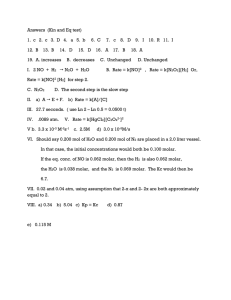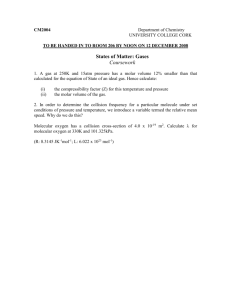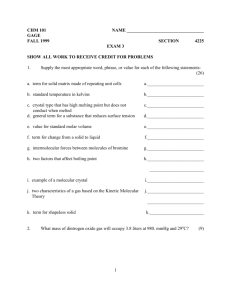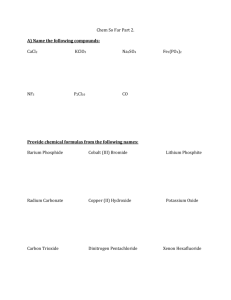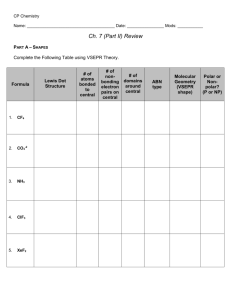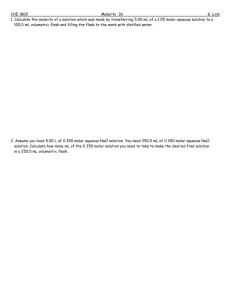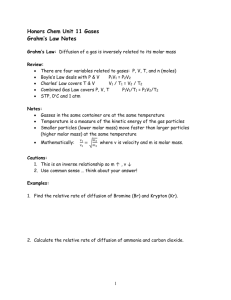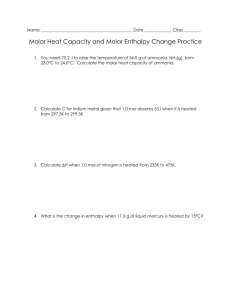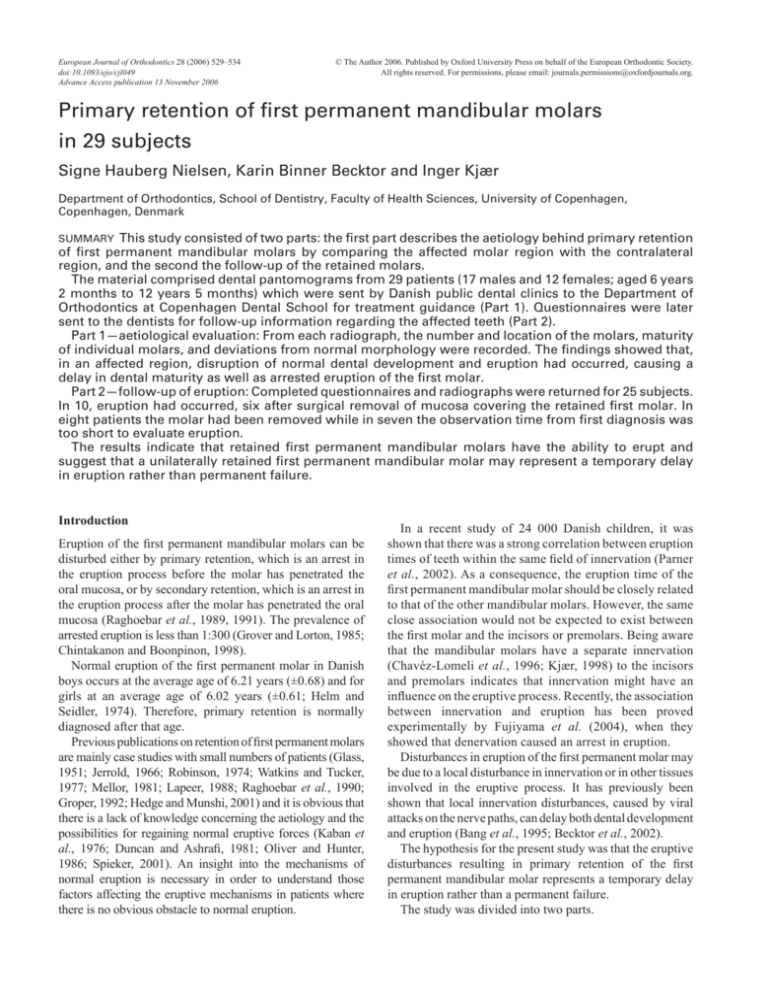
European Journal of Orthodontics 28 (2006) 529–534
doi:10.1093/ejo/cjl049
Advance Access publication 13 November 2006
© The Author 2006. Published by Oxford University Press on behalf of the European Orthodontic Society.
All rights reserved. For permissions, please email: journals.permissions@oxfordjournals.org.
Primary retention of first permanent mandibular molars
in 29 subjects
Signe Hauberg Nielsen, Karin Binner Becktor and Inger Kjær
Department of Orthodontics, School of Dentistry, Faculty of Health Sciences, University of Copenhagen,
Copenhagen, Denmark
SUMMARY This study consisted of two parts: the first part describes the aetiology behind primary retention
of first permanent mandibular molars by comparing the affected molar region with the contralateral
region, and the second the follow-up of the retained molars.
The material comprised dental pantomograms from 29 patients (17 males and 12 females; aged 6 years
2 months to 12 years 5 months) which were sent by Danish public dental clinics to the Department of
Orthodontics at Copenhagen Dental School for treatment guidance (Part 1). Questionnaires were later
sent to the dentists for follow-up information regarding the affected teeth (Part 2).
Part 1—aetiological evaluation: From each radiograph, the number and location of the molars, maturity
of individual molars, and deviations from normal morphology were recorded. The findings showed that,
in an affected region, disruption of normal dental development and eruption had occurred, causing a
delay in dental maturity as well as arrested eruption of the first molar.
Part 2—follow-up of eruption: Completed questionnaires and radiographs were returned for 25 subjects.
In 10, eruption had occurred, six after surgical removal of mucosa covering the retained first molar. In
eight patients the molar had been removed while in seven the observation time from first diagnosis was
too short to evaluate eruption.
The results indicate that retained first permanent mandibular molars have the ability to erupt and
suggest that a unilaterally retained first permanent mandibular molar may represent a temporary delay
in eruption rather than permanent failure.
Introduction
Eruption of the first permanent mandibular molars can be
disturbed either by primary retention, which is an arrest in
the eruption process before the molar has penetrated the
oral mucosa, or by secondary retention, which is an arrest in
the eruption process after the molar has penetrated the oral
mucosa (Raghoebar et al., 1989, 1991). The prevalence of
arrested eruption is less than 1:300 (Grover and Lorton, 1985;
Chintakanon and Boonpinon, 1998).
Normal eruption of the first permanent molar in Danish
boys occurs at the average age of 6.21 years (±0.68) and for
girls at an average age of 6.02 years (±0.61; Helm and
Seidler, 1974). Therefore, primary retention is normally
diagnosed after that age.
Previous publications on retention of first permanent molars
are mainly case studies with small numbers of patients (Glass,
1951; Jerrold, 1966; Robinson, 1974; Watkins and Tucker,
1977; Mellor, 1981; Lapeer, 1988; Raghoebar et al., 1990;
Groper, 1992; Hedge and Munshi, 2001) and it is obvious that
there is a lack of knowledge concerning the aetiology and the
possibilities for regaining normal eruptive forces (Kaban et
al., 1976; Duncan and Ashrafi, 1981; Oliver and Hunter,
1986; Spieker, 2001). An insight into the mechanisms of
normal eruption is necessary in order to understand those
factors affecting the eruptive mechanisms in patients where
there is no obvious obstacle to normal eruption.
In a recent study of 24 000 Danish children, it was
shown that there was a strong correlation between eruption
times of teeth within the same field of innervation (Parner
et al., 2002). As a consequence, the eruption time of the
first permanent mandibular molar should be closely related
to that of the other mandibular molars. However, the same
close association would not be expected to exist between
the first molar and the incisors or premolars. Being aware
that the mandibular molars have a separate innervation
(Chavéz-Lomeli et al., 1996; Kjær, 1998) to the incisors
and premolars indicates that innervation might have an
influence on the eruptive process. Recently, the association
between innervation and eruption has been proved
experimentally by Fujiyama et al. (2004), when they
showed that denervation caused an arrest in eruption.
Disturbances in eruption of the first permanent molar may
be due to a local disturbance in innervation or in other tissues
involved in the eruptive process. It has previously been
shown that local innervation disturbances, caused by viral
attacks on the nerve paths, can delay both dental development
and eruption (Bang et al., 1995; Becktor et al., 2002).
The hypothesis for the present study was that the eruptive
disturbances resulting in primary retention of the first
permanent mandibular molar represents a temporary delay
in eruption rather than a permanent failure.
The study was divided into two parts.
530
S. H. NIELSEN ET AL.
Part 1: to describe the findings in a large number of subjects with unilateral primary retention of the first permanent
mandibular molar and to establish potential aetiological
factors through a comparison of the affected region with the
unaffected contralateral region.
Part 2: to follow-up the affected patients and to establish
whether the teeth erupted during this period.
Subjects and methods
Radiographic material from 29 patients (17 males and 12
females; aged 6 years 2 months to 12 years 5 months) was
included in the investigation. All subjects were healthy with
no systemic or dental disease, except the unilaterally
retained first permanent mandibular molar.
The radiographs were sent by Danish dentists to the
Department of Orthodontics, Copenhagen School of Dentistry
for assistance with diagnosis and treatment planning. No
patients were actually examined or treated in the department.
In collaboration with the patients, the dentists themselves
decided on a treatment plan. Specific plans were not provided
by the department.
Part 1 Dental pantomograms, obtained at the time when
the condition was first diagnosed, were available for all patients. The average age at first diagnosis was 9 years and 2
months (standard deviation ± 1.62). For 12 subjects, followup dental pantomograms were also available. The following
conditions were evaluated by contralateral comparison on
each dental pantomogram.
Number of molars. The number and location of the molars
in the affected region of the mandible (the region enclosing
the primary retained first permanent molar) were compared
with the number and location of molars in the contralateral
unaffected region.
Dental maturity. The stage of dental maturity was
assessed according to the morphological descriptions
by Demirijan et al. (1973). For each of the age maturity
stages, scores from 1 to 8 were given (Figure 1). When
enamel formation was not yet visible, the tooth was
scored as 0.
Morphological deviations in the molar regions. Deviations
in the morphology of the molar crown and root were
recorded. Additionally, the crown follicle of the retained
molar was described.
Part 2 Questionnaires were sent to the referring dentists
between 1 and 8 years after the initial correspondence. For
25 of the 29 subjects, the completed questionnaire was returned (Figure 2). The questions concerned the treatment
undertaken and the eruptional status of the affected tooth.
From the replies received, it was determined whether eruption of the affected molar had occurred naturally or following surgical intervention.
Results
Part 1: description and aetiological evaluation
Number of molars. The number and location of the molars
in the affected area were as follows: in two cases only the
first molars (Figure 3a); in nine cases first and second molars
(Figure 3b); and in 18 cases the first, second, and third
molars (Figure 3c).
Dental maturity. In 17 of the 29 patients, there was
delayed maturity in the affected region when compared with
the contralateral region (Figure 3d–f). The delay concerned
the first molar as well as other molars in the affected region
(Table 1).
In no subject was the affected region advanced in dental
maturity compared with the contralateral region.
Morphological deviations in the molar regions. In four
patients, the crown of the affected molar was enlarged
Figure 1 Morphological stages of molar maturation according to Demirijan et al. (1973),
published with permission. NB: the numbers indicate the individual score given in the present
study for comparison of dental maturation.
531
PRIMARY RETENTION OF FIRST MANDIBULAR MOLARS
Figure 2 Questionnaire sent to the referring dentists to establish the eruptional status of the first
permanent mandibular molar.
compared with the root complex (Figure 3a,b) and in four
subjects root deviations occurred (Figures 3f and 4a).
In addition, the crown follicle of the retained molar was
often enlarged compared with the normal crown follicle
(Figure 3a,b).
Part 2: follow-up of eruption
The questionnaires showed that: eruption had occurred in
10 subjects (six after surgical removal of the mucosa
covering the tooth; Figure 4a,b) while in eight patients the
retained molar had been removed. For seven subjects, the
time between the initial diagnosis and the questionnaire was
too short for evaluation of eruption.
Discussion
The results indicate that the retained first permanent
mandibular molars still have the ability to erupt in some
patients and that a unilateral delay may represent a
temporary problem rather than a permanent failure of
eruption.
The study does not, however, confirm the factors which
could be responsible for this eruptional delay. The delayed
dental maturation in the affected molar region compared
with the contralateral molar region may indicate a
possible local disturbance leading to an arrest in dental
maturation as well as eruption. The question whether a
delay in eruption is caused by an inherited problem in the
tissues involved in the eruptive process or whether it is
caused by an acquired condition disturbing these tissues
is key to our understanding of the aetiology and prognosis
in such patients.
These findings show that unilateral primary retention of
the first permanent mandibular molar appears to be an
acquired disruption of normal eruption; this is based on the
new observation of bilateral differences in dental maturation.
The stages of dental maturation (Demirijan et al. 1973), are
well-defined although sometimes it can be difficult to
classify a case that lies between two stages. In these
situations, the case was scored in the lower stage.
Additionally, the findings show that the affected molar,
in spite of this disruption in the region, is able to regain
eruptive force in some cases, after surgical removal of the
overlying mucosa. Therefore, during treatment planning in
affected patients, consideration should be given to removal
of the overlying mucosa prior to resorting to extraction. It is
also possible that the eight retained first molars, which were
extracted, might still have had some remaining eruptive
forces. However, the dentist may not have been aware of
this, the dentist and/or the patient may have decided on
extraction in any event or the correct time for surgical
removal of the overlying mucosa may have been missed if
the roots had already reached full apical closure. Furthermore,
crowding in the local region could explain the decision to
extract the tooth.
Previous publications (Duncan and Ashrafi, 1981; Groper,
1992; Hedge and Munshi, 2001) have presented only a
small number of cases; hence, it has not been possible to
establish possible aetiological factors or to evaluate the
prognosis for eruption. The present study is based on
material from a number of different dentists and, although
diversity in the material might be criticized, it is the only
way to collect sufficient data when dealing with relatively
rare conditions. With this in mind, Danish public dental
532
S. H. NIELSEN ET AL.
Figure 3 Dental pantomograms of (a) a boy (9 years 8 months) with a primary retained left first permanent mandibular molar. The crown of the affected
molar is enlarged compared with the root complex and the follicle is enlarged. Agenesis of the second and third molars is also observed in the affected
region. (b) A boy (7 years 5 months) with a primary retained left first permanent mandibular molar. The crown of the affected molar is enlarged compared
with the root complex and the follicle of the retained molar is enlarged. Agenesis of the third molar is also present in the affected region. (c) A boy (9 years
6 months) with a primary retained left first permanent mandibular molar. The distal part of the root complex of the affected molar is hook-shaped. (d) A girl
(7 years 11 months) with a primary retained right first permanent mandibular molar. Dental maturity of the affected molar region, especially the second
permanent molar, is delayed compared with the unaffected contralateral molar. (e) A boy (8 years 3 months) with a primary retained right first permanent
mandibular molar. Dental maturity of the affected molar region, especially the first permanent molar, is delayed compared with the unaffected contralateral
molar. (f) A girl (8 years 1 month) with a primary retained left first permanent mandibular molar. A hook-shaped mesial root is apparent. Dental maturity
of the affected molar region is also delayed compared with the unaffected contralateral molar region.
clinics present a unique possibility for screening patients, as
approximately 98 per cent of all Danish children receive
free dental treatment.
One question that has not been answered in this study
concerns the factors that cause unilateral deviation in dental
development and eruption. In previous evaluations of
patients with eruption problems affecting teeth other than
first molars, it has been shown that viral infections, for
example mumps, can affect dental development and eruption
(Bang et al., 1995; Becktor et al., 2002). One way in which
a viral attack might affect dental development and eruption
is by the virus spreading along the peripheral nerve paths to
the teeth. This could cause a temporary de-myelinization of
the nerve fibres, which again could explain the reduced
activity at the nerve endings. It has been shown that
myelinized nerve endings are present in close proximity to
the tooth (Lambrichts et al., 1993) and it has also been
documented experimentally that destruction of the nerve
fibres around the teeth influence eruption (Fujiyama et al.,
2004) and osteoclast activity (Talic et al., 2003).
It is well-known from the literature that the mumps virus
can cause temporary hearing loss (Lee et al., 1978; Yamamoto
533
PRIMARY RETENTION OF FIRST MANDIBULAR MOLARS
Table 1 Bilateral comparison of molar maturation in 29 subjects with unilateral primary retention of the first permanent mandibular
molar
Subject
M (9 y 8 m)
M (9 y 9 m)
M (8 y 3 m)
F (9 y 7 m)
M (8 y 9 m)
M (8 y 11 m)
M (7 y 5 m)
F (7 y 11 m)
F (8 y 3 m)
F (9 y 4 m)
F (11 y 7 m)
F (8 y 2 m)
M (9 y 0 m)
F (6 y 2 m)
M (11 y 1 m)
F (9 y 11 m)
M (11 y 11 m)
M (12 y 5 m)
F (8 y 1 m)
M (6 y 10 m)
M (9 y 6 m)
F (7 y 10 m)
M (8 y 6 m)
F (11 y 3 m)
M (8 y 10 m)
F (7 y 11 m)
M (11 y 7 m)
M (13 y 1 m)
M (8 y 6 m)
Molar scores in A region
M3inf
M2inf
M1inf
X
X
X
X
X
X
X
X
X
X
X
1
0
0
0
1
0
1
1
0
2
0
0
2
0
0
2
1
0
X
X
4
6
3
4
4
2
4
4
7
5
4
4
4
5
5
5
4
4
5
4
4
6
5
3
7
5
4
7
7
6
7
6
7
6
6
7
6
8
8
7
6
7
8
8
8
7
6
7
7
8
8
7
7
8
7
7
A sum
7
7
10
13
9
11
10
8
11
10
15
14
11
10
11
14
13
14
12
10
14
11
12
16
12
11
17
13
12
Molar scores in U region
M1inf
M2inf
M3inf
7
7
7
8
6
8
7
7
7
7
8
8
8
6
8
8
8
8
8
7
8
7
8
8
7
7
8
7
7
4
5
4
6
4
4
4
4
4
4
7
5
6
4
4
5
5
6
5
4
5
4
4
6
5
4
7
5
4
0
0
X
X
X
X
X
X
X
X
X
1
1
0
0
2
1
1
1
0
3
0
0
2
0
0
2
1
1
U sum
U sum−A sum
Figure
11
12
11
14
10
12
11
11
11
11
15
14
15
10
13
16
14
16
14
11
16
11
12
16
12
12
17
13
12
4
5
1
1
1
1
1
3
0
1
0
0
4
0
2
2
1
2
2
1
2
0
0
0
0
1
0
0
0
Figure 3a
Figure 3e
Figure 3b
Figure 3d
Figures 4a, b
Figure 3f
Figure 3c
Scores are given according to Figure 1. 0, presence of crown follicle before enamel formation is visible; X, agenesis; A, affected molar region: molar
region where retention of the first molar occurred; U, unaffected molar region: the contralateral region not affected by primary retention; M, male, F,
female. Age in parentheses (years and months). Subjects are listed in the following order: 2 cases, only first molars in affected molar field; 9 cases, first
and second molars present in the affected field; and 18 cases, first, second, and third molars.
et al., 1993; Bang et al., 1995). Similarly, viral attacks in the
dentition could result in a temporary delay in dental maturation
and eruption. How peripheral nerves affect the eruptive
mechanisms is another question not answered in this study.
The present research focused on unilaterally retained first
permanent mandibular molars only. Bilaterally retained first
permanent mandibular molars are likely to have different
aetiological factors. The incidence of bilateral retained first
mandibular molars is significantly lower, and it will take
years of gathering sufficient material to be able to understand
this condition adequately.
Conclusions
A unilaterally retained first permanent mandibular molar is
an acquired condition and the findings suggest that there is
a high probability of eruption after surgical removal of the
mucosa covering the tooth, provided this is undertaken
before apical root closure.
The results of this study suggest that a unilaterally
retained first permanent mandibular molar represents a
temporary delay in eruption rather than permanent failure.
Radiographic evaluation showed an enlarged dental follicle
associated with the affected tooth in a number of subjects
and 17 of the 29 patients showed delay in the dental
maturity of the molars on the affected side compared with
the normal side. In a follow-up study of 25 of the 29 cases,
eruption occurred in 10 subjects, six of these after surgical
exposure.
Address for correspondence
Professor Inger Kjær
Department of Orthodontics
School of Dentistry
Faculty of Health Science
University of Copenhagen
Nørre Alle 20
DK-2200 Copenhagen N
Denmark
E-mail: ik@odont.ku.dk
534
Figure 4 Pantomogram of a (a) boy (11 years 11 months) with a primary
retained right first permanent mandibular molar. Root deviations (hookshaped distal root complex) are apparent. Dental maturity of the third
molar in the affected molar region is also delayed compared with the
unaffected contralateral molar. (b) Follow-up pantomogram of the same
boy (Figure 4a) 4 years later (15 years 11 months) with the molar fully
erupted. The retained molar erupted after surgical exposure without further
orthodontic treatment.
Acknowledgements
The authors wish to thank the dentists in the Danish
public dental clinics for collaboration; the IMK Foundation for funding, and Maria Kvetny for manuscript
preparation.
References
Bang E, Kjær I, Christensen L R 1995 Etiological aspects and orthodontic
treatment of unilateral localized arrested tooth development combined
with hearing loss. American Journal of Orthodontic and Dentofacial
Orthopedics 108: 154–161
Becktor K B, Bangstrup M I, Rølling S, Kjær I 2002 Unilateral primary or
secondary retention of permanent teeth and dental malformations.
European Journal of Orthodontics 24: 205–214
Chavéz-Lomeli M E, Mansilla Lory J, Pompa J A, Kjær I 1996 The human
mandibular canal arises from three separate canals innervating different
tooth groups. Journal of Dental Research 75: 1540–1544
Chintakanon K, Boonpinon P 1998 Ectopic eruption of the first permanent
molars: prevalence and etiological factors. Angle Orthodontist 68:
153–160
Demirijan A, Goldstein H, Tanner J M 1973 A new system of dental age
assessment. Human Biology 45: 211–227
Duncan W K, Ashrafi M H 1981 Ectopic eruption of the mandibular first
permanent molar. Journal of the American Dental Association 102:
651–654
S. H. NIELSEN ET AL.
Fujiyama K, Yamashiro T, Fukunaga T, Balam T A, Zheng L, TakanoYamamoto T 2004 Denervation resulting in dento-alveolar ankylosis
associated with decreased Malassez epithelium. Journal of Dental
Research 83: 625–629
Glass D F 1951 A case of an unerupted first permanent molar with second
premolar and second and third molars in position. Dental Record 70:
74–78
Groper J N 1992 Ectopic eruption of a mandibular first permanent
molar. Report of an unusual case. Journal of Dentistry in Children 59:
228–230
Grover P, Lorton L 1985 The incidence of unerupted permanent teeth and
related clinical cases. Oral Surgery, Oral Medicine, and Oral Pathology
59: 420–425
Hedge S, Munshi A K 2001 Management of an impacted, dilaterated
mandibular left permanent first molar. A case report. Quintessence
International 32: 235–237
Helm S, Seidler B 1974 Timing of permanent tooth emergence in Danish
children. Community Dentistry and Oral Epidemiology 2: 122–129
Jerrold L J 1966 Bilateral impaction of mandibular first, second, and third
molars. American Journal of Orthodontics 52: 190–210
Kaban L B, Needleman H L, Hertzberg J 1976 Idiopathic failure of eruption
of permanent molar teeth. Oral Surgery, Oral Medicine, and Oral
Pathology 42: 155–163
Kjær I 1998 Prenatal traces of aberrant neurofacial growth. Acta
Odontologica Scandinavica 56: 326–330
Lambrichts I, Creemers J, Van Steenberghe D 1993 Periodontal neural
endings intimately relate to epithelial rests of Malassez in humans. A
light and electron microscope study. Journal of Anatomy 182: 153–162
Lapeer G L 1988 Impaction of the first permanent molar. Journal of the
Canadian Dental Association 54: 113–114
Lee M-I, Levin L S, Kopstein E 1978 Autosomal recessive sensorineural
hearing impairment, dizziness, and hypodontia. Archives of
Ortolaryngology—Head and Neck Surgery 104: 292–293
Mellor T K 1981 Six cases of non-eruption of the first adult lower molar.
Journal of Dentistry 9: 84–88
Oliver R G, Hunter B 1986 Submerged permanent molars: four case
reports. British Dental Journal 160: 128–130
Parner E T, Heidmann J M, Kjær I, Væth M, Poulsen S 2002 Biological
interpretation of the correlation of emergence times of permanent teeth.
Journal of Dental Research 81: 451–454
Raghoebar G M, Boering G, Jansen H W B, Vissink A 1989 Secondary
retention of permanent molars: a histological study. Journal of Oral
Pathology and Medicine 18: 427–431
Raghoebar G M, van Koldam V A, Boering G 1990 Spontaneous reeruption
of a secondarily retained permanent lower molar and an unusual
migration of a lower third molar. American Journal of Orthodontic and
Dentofacial Orthopedics 97: 82–84
Raghoebar G M, Boering G, Vissink A, Stegenga B 1991 Eruption
disturbances of permanent molars. Journal of Oral Pathology and
Medicine 20: 159–166
Robinson P B 1974 An unusual mandibular first molar—a case report.
British Dental Journal 136: 458–459
Spieker R D 2001 Submerged permanent teeth: literature review and case
report. General Dentistry 49: 64–68
Talic N F, Evan C A, Daniel J C, Zaki A E M 2003 Proliferation of
epithelial rests of Malassez during experimental tooth movement.
American Journal of Orthodontic Dentofacial Orthopedics 123:
527–533
Watkins J J, Tucker G J 1977 An unusual form of impaction of two
permanent molars: a case report. Journal of Dentistry 5: 215–218
Yamamoto M, Watanabe Y, Mizukoshi K 1993 Neurotological findings in
patients with acute mumps deafness. Acta Otolaryngologica Supplement
504: 94–99

